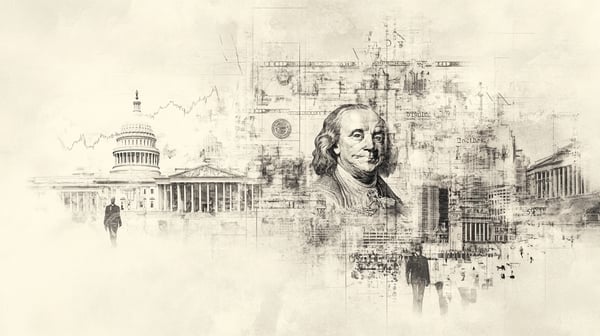Will AI and Blockchain bring repo market out of the shadows?

The repurchase agreement (repo) market is a fundamental component of the global financial system, serving as a crucial mechanism for short-term funding and liquidity management. By allowing financial institutions to engage in collateralized borrowing and lending, the repo market facilitates efficient capital allocation, enhances market liquidity, and supports the functioning of the broader monetary system. It plays a particularly vital role in the modern eurodollar system, where liquidity and credit are created outside of traditional central banking frameworks.
The opacity and complexity of the repo market stem from its decentralized structure, reliance on collateral rather than traditional money, and the extensive use of rehypothecation (a topic for another time). Unlike conventional lending, where cash moves directly between borrowers and lenders, repo transactions involve the temporary exchange of securities for short-term funding, often in a multi-layered, interbank environment. Many of these transactions occur in the shadow banking system, outside of regulated frameworks, making it difficult to track exposures and counterparty risks. Additionally, the widespread practice of rehypothecation—where the same collateral is reused multiple times across different transactions—amplifies systemic interconnectedness and potential vulnerabilities. Because these transactions are largely bilateral and often occur through bespoke agreements rather than centralized clearinghouses, transparency is limited, making it challenging to assess liquidity conditions, risk concentrations, and market stress points. Recognizing these challenges, the Office of Financial Research (OFR) sought to examine the repo market’s structure and identify the key factors driving its activity.
At its core, the market is divided into two primary segments: the bilateral repo market and the centrally cleared (or tri-party) repo market. In the bilateral segment, transactions occur directly between counterparties, often involving hedge funds, broker-dealers, and non-bank financial institutions. This segment is less transparent, as agreements are privately negotiated and collateral rehypothecation is more common. The tri-party segment, on the other hand, involves central clearing agents, such as the Bank of New York Mellon (BNYM) or the Fixed Income Clearing Corporation (FICC), which facilitate settlements and reduce counterparty risk by acting as intermediaries.
The key players in the repo market include banks, non-bank financial institutions, money market funds, pension funds, insurance companies, and central banks. Banks and broker-dealers, such as JPMorgan Chase, Goldman Sachs, and Citigroup, act as major intermediaries, using repo transactions for short-term funding and collateral transformation. Hedge funds and asset managers utilize repos to finance leveraged positions, particularly in the U.S. Treasury market. Money market funds and pension funds serve as major cash lenders, seeking low-risk returns on their excess liquidity. Central banks, particularly the Federal Reserve, engage in repo operations to influence short-term interest rates and manage liquidity conditions in the banking system.
Estimates of the repo market’s size vary due to its opacity, but as of recent assessments, the total market is estimated to exceed $4 trillion in daily volume in the U.S. alone. The tri-party repo segment accounts for approximately $2.5 trillion, while the bilateral market is more difficult to quantify but is believed to be of a similar or even larger magnitude. Globally, the market is substantially larger, with the eurodollar system and offshore dollar funding contributing significantly to its expansion.
The focus of the OFR study was the non-centrally cleared bilateral repo (NCCBR) market, which remains the largest and least transparent segment of the broader repo market. The study focused on transaction-level data collected from nine dealers over three reporting dates, aiming to assess the structure, pricing, and risk management practices in this opaque market.
One of the key findings of the study was that the NCCBR segment differs from centrally cleared repo markets primarily due to the flexibility it provides in terms of haircuts and netting arrangements. Unlike centrally cleared transactions, where standard collateral requirements and margining practices apply, NCCBR transactions often occur with zero haircuts—particularly for U.S. Treasuries. Over 70% of Treasury repos in this segment were conducted with no haircut at all, suggesting that counterparty relationships and balance sheet netting considerations drive participation in this market rather than traditional risk-based pricing.
The study also found that non-centrally cleared repo provides greater flexibility in contract terms, particularly in longer-tenor trades and the use of non-standard collateral. While centrally cleared repo primarily involves Fedwire-eligible securities, NCCBR allows participants to use a wider range of collateral types, including less liquid assets. This makes it an attractive venue for hedge funds and other non-bank entities engaged in complex arbitrage and relative-value trades.
The OFR concluded that the lack of central clearing in this segment presents both advantages and risks. On the one hand, the ability to negotiate custom terms enables market participants to optimize funding strategies. On the other hand, the absence of centralized risk management increases counterparty exposure and limits regulatory oversight, raising potential financial stability concerns. The study highlighted, that forthcoming regulatory changes, including the SEC’s proposed expansion of centrally cleared Treasury repo, could significantly alter market dynamics by shifting volumes away from NCCBR.
By shifting more repo volume to central clearing, regulators seek to standardize risk management practices, enforce consistent margining and collateral requirements, and reduce the risk of liquidity disruptions. The SEC’s proposal emphasizes that central clearing can provide greater resilience during periods of market stress, ensuring that repo transactions remain settled even if a counterparty defaults. This move is particularly relevant in light of recent market events, such as the liquidity strains experienced in the Treasury market during March 2020, which underscored the fragility of non-cleared funding channels.
However, expanding central clearing is not without challenges. The requirement to clear Treasury repos through FICC would impose additional costs on market participants, particularly smaller dealers and hedge funds that rely on flexible bilateral agreements. Counterparty limits are also a crucial consideration. Some argue that these changes could push certain transactions into even less transparent corners of the financial system or increase demand for alternative funding mechanisms that remain outside regulatory reach.
The integration of artificial intelligence (AI) into the repo market can enhance efficiency, improving risk management, and reshaping market structure. AI-driven automation could streamline collateral optimization, real-time pricing, and counterparty risk assessment, allowing for faster and more precise decision-making. By leveraging machine learning algorithms, financial institutions could optimize funding strategies, dynamically adjust haircuts based on changing market conditions, and detect anomalies in pricing and liquidity flows. This increased efficiency could reduce transaction costs and enhance market liquidity.
Regulators such as the SEC could deploy AI to accelerate the transition toward a fully centrally cleared repo market. AI-powered surveillance systems could analyze trade flows and transaction patterns to detect non-cleared bilateral repos, automatically flagging counterparties that fail to comply with new clearing mandates. Predictive analytics could be used to model stress scenarios and assess systemic risks associated with NCCBR transactions, providing regulators with real-time insights into market vulnerabilities. Additionally, AI-enhanced enforcement mechanisms could dynamically adjust margin requirements and regulatory thresholds based on evolving risk conditions, further incentivizing market participants to transition toward central clearing.
On the other side of the market, dealers and hedge funds could use AI to counteract centralization trends and maintain the flexibility of bilateral repo agreements. Advanced AI algorithms could facilitate decentralized liquidity networks, allowing counterparties to execute repo transactions in a peer-to-peer framework without reliance on a centralized clearinghouse. Furthermore, dealers could deploy AI for regulatory arbitrage, identifying gaps in compliance frameworks and structuring repo transactions in a way that circumvents strict clearing requirements while maintaining sufficient liquidity access.
The introduction of blockchain technology into the repo market could also fundamentally reshape its operational structure. By enabling decentralized and immutable transaction records, blockchain could improve the overall integrity of the repo market, reducing counterparty risk and streamlining settlement processes.
From an operational perspective blockchain-based smart contracts could automate repo agreements, ensuring real-time execution, collateral management, and settlement without manual intervention. These self-executing contracts could dynamically adjust collateral requirements based on predefined conditions, minimizing disputes and enhancing liquidity management. Blockchain’s transparency would also provide real-time visibility into collateral flows, reducing the risk of hidden leverage and excessive rehypothecation. Additionally, tokenization of collateral assets—such as U.S. Treasuries—could facilitate fractional ownership, expanding access to the repo market and improving collateral mobility.
Regulators, particularly the SEC, could leverage blockchain to enforce central clearing mandates and eliminate opacity in NCCBR transactions. A blockchain-based settlement infrastructure could provide real-time surveillance of all repo trades, ensuring that transactions comply with regulatory requirements. By integrating AI with blockchain, regulators could create an automated enforcement mechanism where non-compliant transactions are flagged or even prevented at the execution stage. Moreover, blockchain’s immutable ledger would enable continuous auditing and risk assessment, reducing the need for post-trade reconciliation and enhancing systemic stability.
On the dealer side, blockchain could provide opportunities to counteract the trend toward centralization by enabling a decentralized, peer-to-peer repo market. Dealers could use private blockchain networks to establish trusted liquidity pools outside traditional clearing mechanisms, preserving the flexibility of bilateral agreements while maintaining real-time transparency and risk management. AI-driven smart contracts could be programmed to optimize counterparty selection, dynamically adjusting trade terms based on market conditions and liquidity needs. Additionally, distributed ledger technology could facilitate cross-border repo transactions, reducing settlement times and mitigating the inefficiencies associated with traditional correspondent banking networks.
The post-GFC era has exposed deep structural flaws in the eurodollar system—liquidity shortages, collateral constraints, counterparty risks, and a fragile reliance on confidence rather than centralized oversight. Despite repeated interventions by central banks, the fundamental issues remain unresolved, as the modern monetary system is not built on reserves or printed cash but on a highly intricate network of interbank liabilities, collateralized lending, and synthetic dollar creation. If AI and blockchain are to serve as meaningful tools in repairing this broken system, their implementation must focus on reinforcing liquidity, enhancing transparency, and restoring trust in the decentralized architecture of the market.
AI can be leveraged to dynamically manage collateral shortages, optimize repo markets, and prevent liquidity crises before they escalate. One of the major post-GFC problems has been the inconsistent availability of high-quality collateral, leading to repeated repo market disruptions (e.g., 2019’s repo spike). AI-driven collateral optimization models could allocate collateral more efficiently across counterparties, ensuring that liquidity is neither trapped nor misallocated. Machine learning could be employed to detect early signs of stress in the offshore dollar system, predicting liquidity shortages and adjusting collateral flows accordingly. This would allow repo and derivative markets to function more predictably, reducing the potential for sudden funding freezes.
Blockchain technology, on the other hand, could address the opacity that has plagued the eurodollar system by creating a decentralized but transparent ledger of liabilities and collateral movements. A distributed ledger for repo transactions, securities lending, and dollar swaps would ensure that market participants have a clear view of counterparty risk, preventing the kind of hidden leverage that led to the systemic collapse in 2008.
Central banks have repeatedly failed to supply the right kind of liquidity at the right time because they fundamentally do not operate within the global shadow money system. Instead of relying on central banks to act as lenders of last resort, AI and blockchain could help recreate the elasticity that made the system functional before GFC. AI could enhance liquidity efficiency, and blockchain could enforce counterparty trust without requiring direct central bank intervention.
Regulators should not seek to forcibly centralize all transactions but rather encourage technological innovations that make the market function as it was intended—an efficient, decentralized global dollar system that does not collapse every time liquidity conditions tighten. The post-GFC era has been defined by patchwork solutions and increasing fragility—perhaps it’s time to stop applying band-aids and start using technology to rebuild the system from the ground up.




